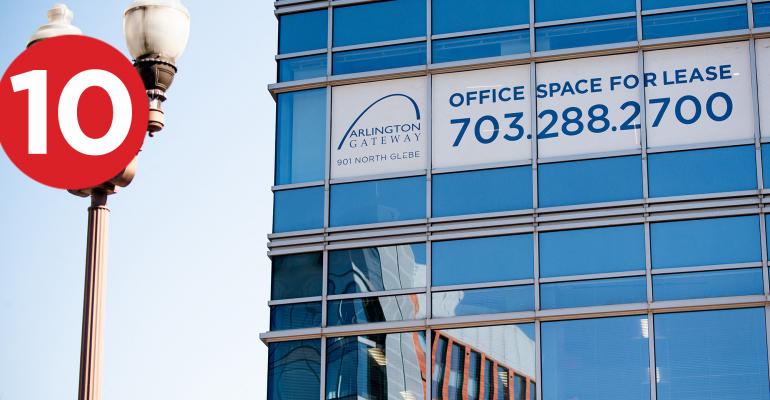- Record High Lease Expirations Pose New Threat to Landlords and Banks “A record amount of U.S. office space is hitting the market this year due to a jump in lease expirations, putting property owners in a bind and threatening to leave banks and other lenders stuck with more troubled loans. Most office building owners have been able to ride out the pandemic because corporate tenants have been locked into long-term leases. They continued paying rent even when their employees stayed home. Now as more leases expire, a growing number of tenants are shrinking their offices because they need less space under hybrid strategies that blend office with remote work, brokers say.” (The Wall Street Journal)
- Amid Soaring Demand for Warehouses, an Effort to Make Them Greener “Warehouses and distribution centers, decidedly unsexy buildings, became hot in the coronavirus pandemic as online shopping accelerated the rise in e-commerce and set off a frenzy of buying and building the boxy, low-rise structures, pushing up rents and increasing returns for investors. Now, as investors and others adopt carbon-reduction targets, the challenge is to make those buildings greener.” (The New York Times)
- Congress ‘Must Prohibit’ REITs from Operating Nursing Homes, Lawmaker Says in Scathing Letter “A U.S. Congressman is seeking to put additional scrutiny on nursing homes with certain investors. Rep. Bobby Rush (D-IL) has called on the House Subcommittee on Oversight and Investigations to schedule a hearing on the ‘failures’ of nursing homes during the pandemic, operating practices of real estate investment trusts and the impact both have had on residents, USA Today reported over the weekend. The subcommittee falls under the Committee on Energy and Commerce.” (McKnights Long Term Care News)
- LA’s Warehouses Cost 45 Percent More Than a Year Ago “Getting into the industrial real estate game in Southern California now is a lot more costly than it was a year ago. Los Angeles County’s average asking rent is $1.19 per square foot per month, up a whopping 28 percent compared to one year ago, according to Newmark’s latest report. For investment sales, the average price has hit $279 per square foot, which is 45 percent higher than the first quarter of 2021.” (Commercial Observer)
- Trading Floors Challenge New York Landlords’ Environmental Efforts “Trading floors have always represented the beating heart of major banks: hundreds of people at a time hunched over their computers, yelling, gossiping, chatting on the phone, and, most importantly, generating revenue for their employers. A typical office floor in New York City might have had 150 or 200 people working in it before the pandemic. A standard trading floor at a major financial institution would have seated 400 to 600 people, each of whom used multiple monitors, a desktop computer and a specialized telephone system called a turret, which can process hundreds of simultaneous calls at once.” (Commercial Observer)
- This Map Shows Where People Moved During the Pandemic “Startup founder Haider Ejaz moved from San Francisco to Portland, Oregon in October 2021. Ejaz told Insider's Hana Alberts one reason for the move was because Portland isn't as expensive. ‘For example, it's $3,000 a month just for rent for a one-bedroom apartment in San Francisco. (I lived alone in a one-bedroom apartment in the Sunset district and then in the Castro.) I would spend half that here in Portland,’ Ejaz told Insider.” (Insider)
- CoStar’s Love-Hate Relationship with the Commercial Real Estate Industry “The commercial real estate industry has long had a love-hate relationship with CoStar and vice-versa. Perceived as a necessary research tool for many in the business, the high price is usually what irks people the most. CoStar can run users thousands of dollars per month with variable fees based on service and activity level. But the cost of the subscription is not the only reason the company has raised the ire of so many in the industry.” (Propmodo)
- Ukraine War Drives Shortage in Pig Iron, Pushing Steel Prices Higher “Pig-iron prices are surging, helping reverse a recent decline in the U.S. steel market. Pig iron, a raw form of the metal used in the production of steel, has grown scarce in the weeks following Russia’s invasion of Ukraine, industry executives said. Two-thirds of the 6 million metric tons of pig iron imported by the U.S. last year came from those two countries, according to the U.S. Census Bureau, but the fighting brought Ukrainian shipments to a halt and importers have stopped ordering from Russia, steel executives said.” (The Wall Street Journal)
- What Went Wrong at Maefield Development’s 20 Times Square? “The hotel and retail megaproject was supposed to print money from the heart of Times Square. Instead it turned into a billion-dollar mistake.” (The Real Deal)
- 70% of Interns View Remote Work Negatively, Study Finds “The discrepancy suggests that employers — which are trying to determine the best ratio of in-person to at-home work — may have a tough time making everyone happy in the current pandemic work environment. Much of the value of internships for interns comes from interactions with senior members of an organization, like managers and executives, who often play a mentor role for college-age workers.” (CNBC)
0 comments
Hide comments





